|
Summer at Grazer Kunstverein
14 June – 1 August 2019
My Summer is your Winter
A group exhibition and season of performances featuring works by Fahim Amir, Simnikiwe Buhlungu, Laurie Charles, Chris Evans & Morten Norbye Halvorsen, Dora García, Veronika Hauer, Krõõt Juurak & Alex Bailey and Fiston Mwanza Mujila.
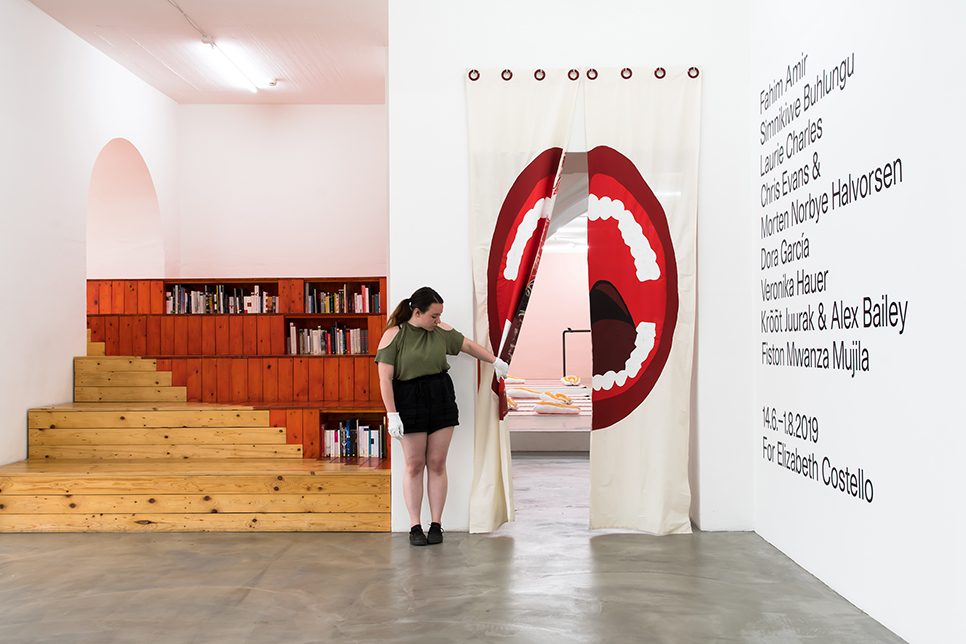
Installation view of My Summer is your Winter at Grazer Kunstverein, 2019. Photography by Christine Winkler
Dear Elizabeth,
You do not exist, at least not in the material world, you are not flesh and blood, you never have been, not as far as I know. And yet for me your voice is real. Ever since I first read J. M. Coetzee’s The Lives of Animals you have preoccupied me. Your conviction of thought and ferocity of will, your relentless spirit, the generosity of your ideas and your lonely campaign to articulate these ideas long before they were popular has made me feel not only for the lives of the animals you defend but for you, a fictional character, a figment of a man’s imagination.
I write to you from my desk at Grazer Kunstverein, a contemporary art institution in Austria. In June we will open a new exhibition, titled My Summer is your Winter, and it is dedicated to you. The exhibition takes place in thresholds. Doorways, passages, jambs. Realms, registers, mindsets. With soft interior furnishings by Laurie Charles, animal-led workshops by Krõõt Juurak and Alex Bailey, ancient telecommunications by Simnikiwe Buhlungu, bodies in a library in a film by Dora García, a troupe of suspended portraits by Veronika Hauer, an interruption of poetry by Fiston Mwanza Mujila, soundwaves across thresholds by Chris Evans and Morten Norbye Halvorsen, and a startling manifesto by Fahim Amir, the exhibition explores the idea of fiction as a method or tool for understanding what it is like to be another (human or nonhuman, real or imaginary). To test the capacity of fiction (by which I also mean art) to elicit empathy for the unknown, and explore forms of consciousness beyond one’s own.
You’re not real in the way that the living are, Elizabeth, and the likelihood is this letter won’t be answered. Nevertheless I sometimes imagine conversations we might have together. About consciousness, and the birds and beasts of the earth, and changes in the world of science and education ever since you first found your way into Coetzee’s books, in 1999. Your awareness of your subjectivity in every argument you make is what mobilises me. I deeply admire your resolve to speak your truth in a world of closed ears, and to eschew your privilege and seize the possibilities of your platform to make some good. I hear your voice in choral harmony with others currently overtaking the didactic, authoritarian, stubborn patriarchal dedication to an idea of “objectivity” that once informed the world about itself. It seems such voices, speaking with deeper capacity for nuance, affect, embodied knowledge, awareness of non-human subjectivities and a taste for the unknown, are becoming louder. In some way, Elizabeth, you opened my ears to this.
From Austria to Australia – where I visualise you still, endlessly striving to express your principles even as life exhausts you, and people diminish you – I write to thank you. We live in different halves of the same world, where your reality is my fiction, and my summer is your winter, but with a modest leap of faith that feels so vital to our survival, your power can be felt. We are humbled to dedicate this show to you.
With fond regards,
Kate Strain
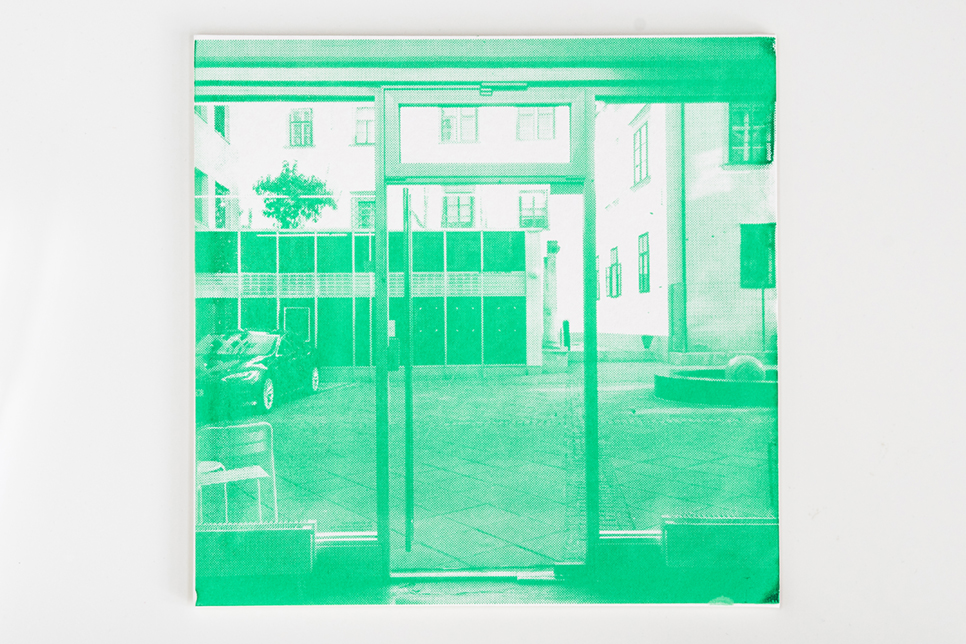
Chris Evans and Morten Norbye Halvorsen, Jingles (Grazer Kunstverein, spring, summer, autumn, winter), 2017–2020. Photography by Christine Winkler
Chris Evans with Morten Norbye Halvorsen
Jingles (Grazer Kunstverein, spring, summer, autumn, winter) was devised by Chris Evans as a series of short musical compositions — varying in duration between 0.74 and 28 seconds — that are activated by sensor upon entry and egress, to cumulatively proclaim and broadcast the arrival and departure of each visitor to Grazer Kunstverein. Evans invited artist & musician Morten Norbye Halvorsen to collaborate on compositions that would correspond with Grazer Kunstverein’s seasonally evolving artistic programme and to create sequences between the institution’s six entrance doors.
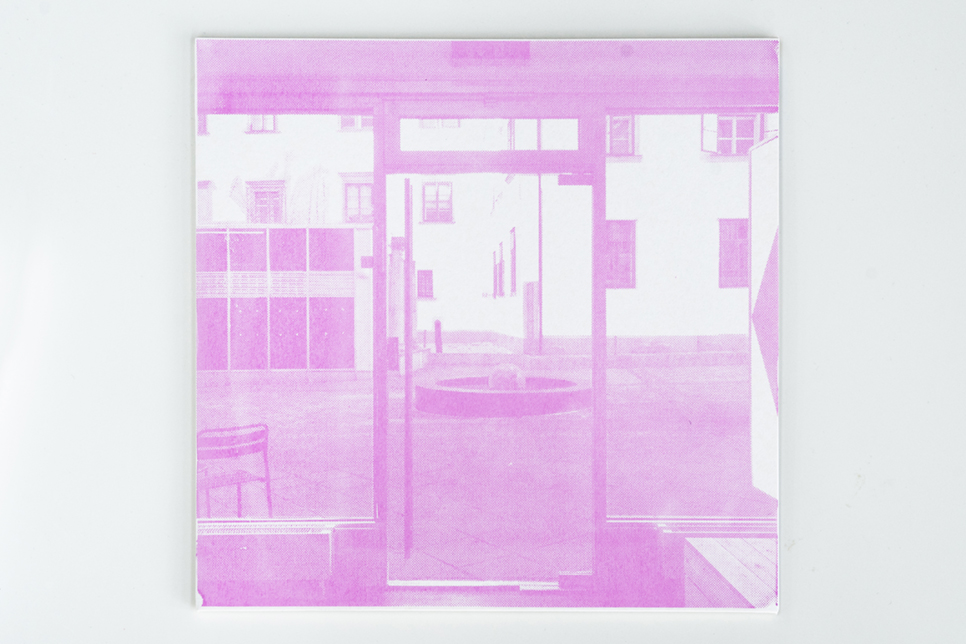
Chris Evans and Morten Norbye Halvorsen, Jingles (Grazer Kunstverein, spring, summer, autumn, winter), 2017–2020. Photography by Christine Winkler
Originally inspired by bass melodies used for interludes in American sitcoms — that connotate scenic transition — the jingles were made from percussive sounds built around Evans’ basslines. In single takes or edited recordings, techniques such as scraping, bottleneck slides and ebow were used percussively and then built around with synthesised sounds. In the spring season Shepard tones, sine-waves, and modal synthesis are present whilst field recordings are introduced in the summer season. Filter envelopes, clave, tubes and resampling feature in the autumn season and for the final season produced — winter — white noise replicates wind noise and an ebow used on bass mimics the call of a deer.

Chris Evans and Morten Norbye Halvorsen, Jingles (Grazer Kunstverein, spring, summer, autumn, winter), 2017–2020. Photography by Christine Winkler
Since the original commission of Jingle by Grazer Kunstverein, the work has developed into a series where Chris Evans first asks after a host’s financial stability. If stable, a farmer – if not, then an accountant – is asked to mimic a non-specific percussive phrase and TV bass-line is added. Jingle has subsequently been commissioned for a number of institutions including Hong Gai Museum, Taipei (2019), SALT Galata, Istanbul (2018), Kunsthalle Oslo (2018), Centre Art Neuchatel, Switzerland (2018) and Para Site, Hong Kong (2017).

Chris Evans and Morten Norbye Halvorsen, Jingles (Grazer Kunstverein, spring, summer, autumn, winter), 2017–2020. Photography by Christine Winkler
All four seasons of the compositions are published as a 12" vinyl LP launched for the summer season 2019 at Grazer Kunstverein. The A side is a recording of each Jingle in sequence by season and for the B side Norbye Halvorsen has produced an edit of the compositions. It opens with a vocoder like bassline, then acoustic sounds from bass played with an ebow imitate a deer call which features on the track as the lead synth. We hear an AI squelch, a campfire banjo strum and an auto clave followed by a real deer cry recorded on a Curonian spit on the Baltic Sea coast, which features in the spring season of the jingles.

Chris Evans and Morten Norbye Halvorsen, Jingles (Grazer Kunstverein, spring, summer, autumn, winter), 2017–2020. Photography by Christine Winkler
The record is published in an edition of 150 signed copies, for which Evans has made a series of silkscreened covers.
The pressing of the record was supported by Liverpool John Moores University. This project was made possible through the generous support of legero united – the shoemakers and their initiative www.con-tempus.eu
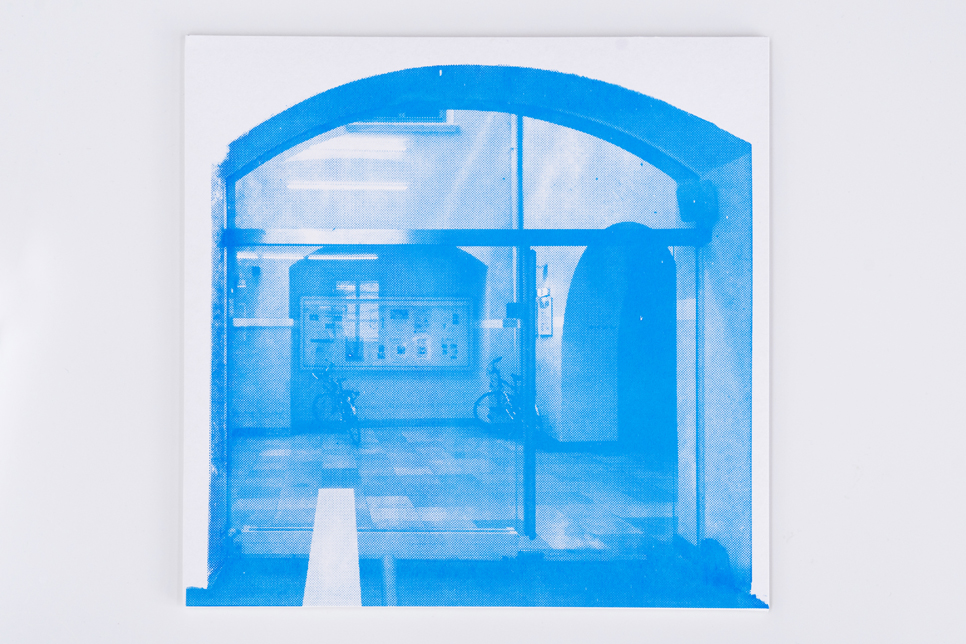
Chris Evans and Morten Norbye Halvorsen, Jingles (Grazer Kunstverein, spring, summer, autumn, winter), 2017–2020. Photography by Christine Winkler
Chris Evans is a Brussels-based artist whose work often evolves through conversation with people from diverse walks of life, selected in relation to their public life or symbolic role. Sculptures, letters, drawings, film scripts and unwieldy social situations created as a result of this, are indexes of a larger structure through which Evans deliberately confuses the roles of artist and patron, author and muse. Evans has exhibited internationally since 2000 with solo exhibitions at institutions that include C.A.N. Centre d’Art Neuchatel (2018), Praxis, Berlin (2015), Project Arts Centre, Dublin (2014), Marres, Maastricht (2010), Objectif Exhibitions, Antwerp (2010), The British School in Rome (2008) and Art Pace, San Antonio (2007). Evans participated in the 6th British Art Show in 2005 and the following year in East International and since then has exhibited in several art Biennials: Athens Biennial in 2007, Taipei Biennial in 2010 and Liverpool Biennial in 2014. In 2016 he was the recipient of a Bryan Robertson Trust Award.
Morten Norbye Halvorsen is an artist and composer based in Berlin and Stavanger. Halvorsen’s work has been included in group and solo exhibitions including HTML Curtain, Gaudel de Stampa, Paris (2019), 9th Norwegian Sculpture Biennial, Vigeland-museet, Oslo (2017), Wave Table Concert, Kunsthall Stavanger (2016), Gain Vapor Rise, Gaudel de Stampa, Paris (2016), All the Instruments Agree, Hammer Museum, Los Angeles (2015), The Companion & Liverpool Biennial, (2014), Pan Exciter, NoPlace, Oslo, Alluvium, Objectif Exhibitions, Antwerpen; oO, The Lithuanian/ Cyprus Pavilion, 55th Venice Biennale (2013), Run, comrade, the old world is behind you, Kunsthall Oslo (2011), Repetition Island, Centre Pompidou, Paris (2010) and Paper Exhibition, Artist Space, New York (2009).

Simnikiwe Buhlungu, A Loooooong Ass Message, Ya Dig? (Refax), 2019, shown as part of My Summer is your Winter, Grazer Kunstverein, 2019. Photography by Christine Winkler
Simnikiwe Buhlungu literally and figuratively disrupts the main foyer of the Grazer Kunstverein with an ongoing series of faxes that interrupt the day-to-day activities of the institution. This one-way conversation, in the absence of Buhlungu’s physical presence, serves to continue a discussion originally started in previous versions of this same work, whereby the artist sought to insert missing narratives and overlooked histories into existing exhibition programmes by way of well researched, sporadic textual intervention.

Simnikiwe Buhlungu, A Loooooong Ass Message, Ya Dig? (Refax), 2019, shown as part of My Summer is your Winter, Grazer Kunstverein, 2019. Photography by Christine Winkler
Foregrounding the idea of self-historicising and selfdetermination and self-writing as forms of knowledge production, this iteration of the project (Refax) departs from ideas around institutional critique and what Buhlungu perceives as missing in plain sight, in many contemporary gallery roll-calls in her hometown and further afield. The incongruency of sending these faxes (as opposed to other forms of “digital” messaging) introduces an unavoidable confrontation of these narratives in print – happening in real time. The faxes – which make use of both image and text – engage with ideas around language, asking how do we understand “text/image”, who writes it? Is it translated when introduced into a different geographical climate? What are the infinite other knowledges, and possibilities, that are located in Johannesburg/South Africa/The Global South, that can activate other ways of thinking elsewhere? The Kunstverein thus functions as a space to facilitate this ongoing conversation.

Simnikiwe Buhlungu, A Loooooong Ass Message, Ya Dig? (Refax), 2019, shown as part of My Summer is your Winter, Grazer Kunstverein, 2019. Photography by Christine Winkler
Simnikiwe Buhlungu was born in 1995, one year after apartheid ended in South Africa. Buhlungu is a Johannesburg-based artist, having obtained her BA (Fine Art) degree from the University of the Witwatersrand, Johannesburg. Through print and text based mediums and often taking installation based forms, Buhlungu’s interest in navigating personal and socio-historical narratives presents itself as a complex web of [re]imagined engagements which are surrounding, but not exclusive to, experiences embedded within the complexity of knowledge production(s) – which are [un]written, [un]spoken, [un]heard, made [in]visible. Through this, her practice begins to develop into conversation between posing questions and attempting to provide answers to these ideas. Her work has also existed through a number of exhibitions, projects and spaces in Johannesburg at Wits Art Museum, Fourthwall Books, Sosesame Gallery, No End Contemporary Gallery, Assemblage, The Point of Order, NGO (Nothing Gets Organised), Stevenson Gallery, Room Gallery & Projects, Keleketla! Library and the Centre for the Less Good Idea. She has also participated in the WIELS Residency Programme, Brussels and the 10th Berlin Biennale.

Laurie Charles, The kidney, 2019, shown as part of My Summer is your Winter, Grazer Kunstverein, 2019. Photography by Christine Winkler
Soft furnishings by Laurie Charles punctuate this exhibition throughout the entire building. This series of newly commissioned works encompass largescale (macro-lens) depictions of that which is ordinarily invisible to the naked eye (interior cells of the body, arteries, veins and microbial materials). These textile drawings act as thresholds, creating staging areas throughout the many rooms of the Grazer Kunstverein. They explore depictions of the inside of the body in ways that are cartoonish, exaggerated and immediately recognizable. They sit within Charles’s artistic practice like props ready for a film to be shot or a scene to be enacted, and they provide the backdrop for unlimited potential scenarios, hidden within the interior micromovements of the body, and our place inside the building, active constituent parts of a much larger organism.
This project was made possible through the generous support of legero united – the shoemakers and their initiative www.con-tempus.eu

Laurie Charles, The kidney, 2019, shown as part of My Summer is your Winter, Grazer Kunstverein, 2019. Photography by Christine Winkler
Laurie Charles lives and works in Brussels. Charles graduated from the Royal Academy of Fine Arts in Bordeaux. As a filmmaker she creates moving image works in which she interweaves folklores, humanities and histories with narrative and speculative fiction. Charles writes and paints, fictions on canvases and speculative narratives. Among other venues, her work has been exhibited at CIAP Kunstverein, Hasselt, 1646 – project space for contemporary art, the Hague, Nanjing International Art Festival, Beursschouwburg, Brussels, Komplot, Brussels, and Le Commissariat, Paris. Charles is a guest teacher for the master of editorial practice program, Royal Academy of Art ArBA EsA, Brussels.
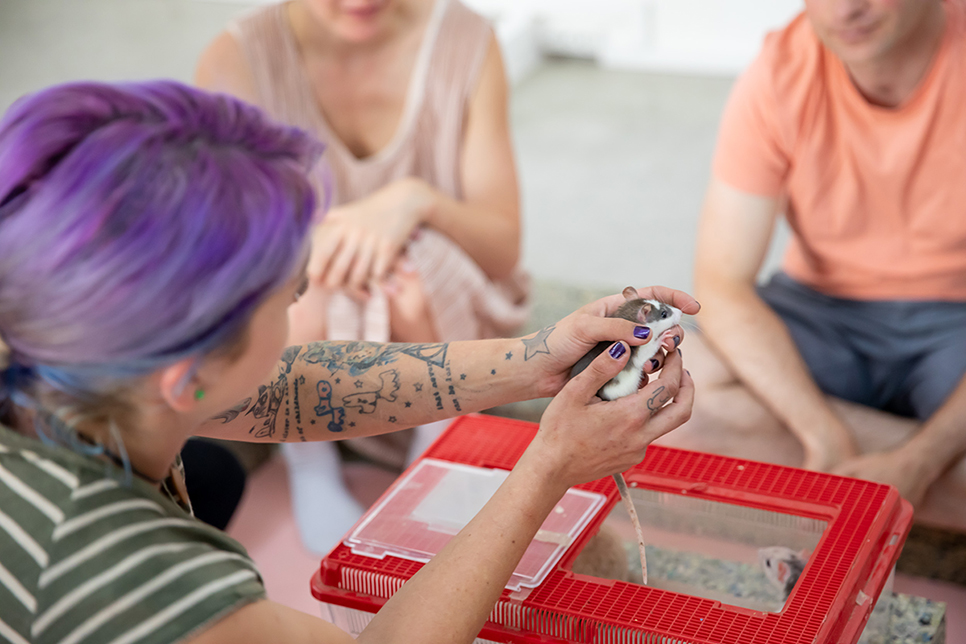
Krõõt Juurak and Alex Bailey, Animal Workshops, 2019, held as part of My Summer is your Winter, Grazer Kunstverein, 2019. Photography by Thomas Raggam
As part of My Summer is your Winter, artists Krõõt Juurak and Alex Bailey have devised a series of animal workshops to be led by pets with specific skill sets. During the hour-long workshop, participants perform a series of exercises as demonstrated by the workshop leaders. Each workshop responds to the specific talents of the animal leader, and so duration, technique and ability level may differ in each case.
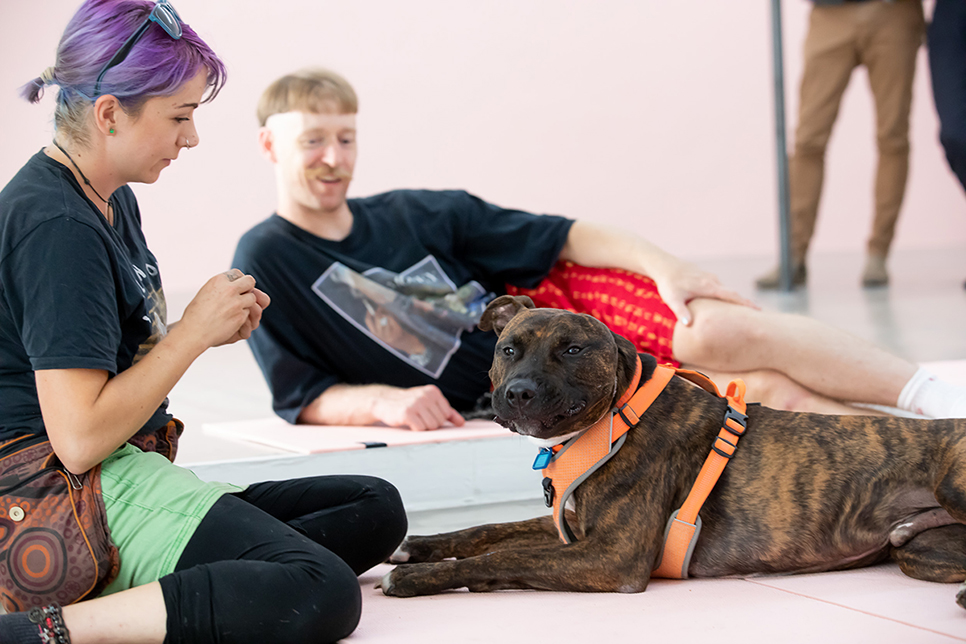
Krõõt Juurak and Alex Bailey, Animal Workshops, 2019, held as part of My Summer is your Winter, Grazer Kunstverein, 2019. Photography by Thomas Raggam
CALL FOR PETS
Artists Krõõt Juurak & Alex Bailey are looking for pets (together with their owners) who would be willing to take part in an art project. If you think that your pet has some special skills that they could share with humans, this might be something for you. The size, species and age of the pet is not as important as the emotional and intellectual connection between you and your pet. The special skills can be anything from sleeping in a public space to flying, to finding small objects on the floor, to concentrating and listening, even resilience or just a positive attitude!
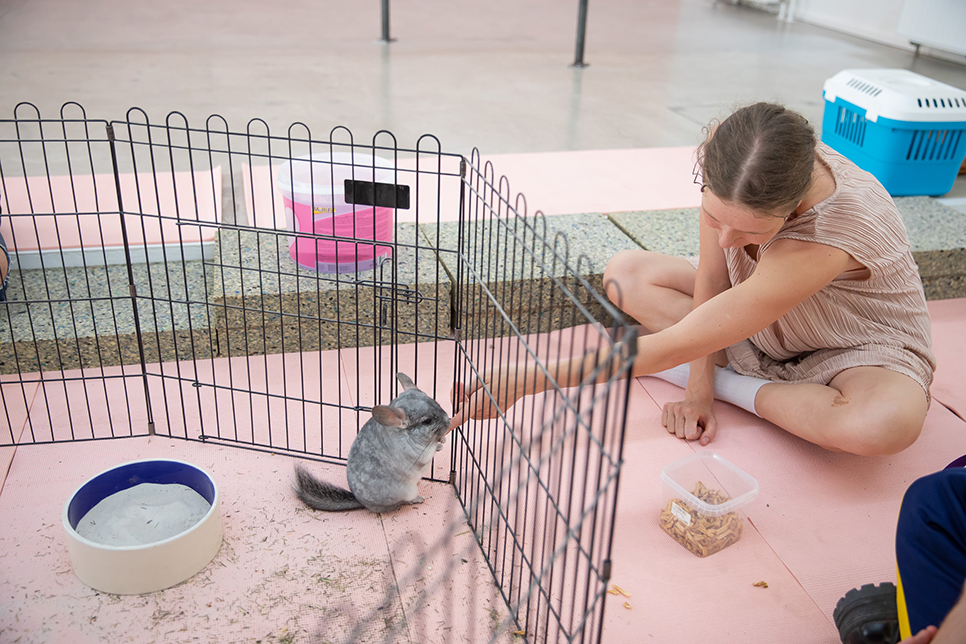
Krõõt Juurak and Alex Bailey, Animal Workshops, 2019, held as part of My Summer is your Winter, Grazer Kunstverein, 2019. Photography by Thomas Raggam
Krõõt Juurak and Alex Bailey are artists and performers based in Vienna. Juurak works through performances, presentations, texts, workshops and mood shifts, to challenge fixed definitions of choreography and performance. She graduated in dance and choreography from ArtEZ, Arnhem in 2003 and obtained an MA in Fine Arts from Sandberg Institute, Amsterdam. Bailey also obtained an MFA at the Sandberg Institute. Together with Juurak they conceived the project Performances for Pets in 2014, which they have performed for over 100 pets in cities and homes across Europe in both visual arts & dance festivals. He is the author of the practice Humourology, a study into humour related cosmic to comic communications. Both Performances for Pets and Humourology are represented by Galerie International, an immaterial gallery dealing exclusively with immaterial artworks run by Adriano Wilfert Jensen and Simon Asencio. As well as Performances for Pets, recent collaborations between Juurak and Bailey include Animal Jokes (for Animals) performed at Secession, Vienna, Xing, Bologna and Bonnefanten Museum Maastricht, Animal Show performed at WUK Performing Arts, Vienna, and Codomestication which was performed at Tanz Quartier Wien in collaboration with Juurak and Bailey’s young son, Albert.

Dora García, La Eterna, 2017, shown as part of My Summer is your Winter, Grazer Kunstverein, 2019. Photography by Christine Winkler
Inspired by the eponymous novel by cult Argentinian author Macedonio Fernandez, La Eterna (2017) is a science fiction short film by Dora García, in which a group of characters discuss repetition, metafiction, acting, and the work of psychoanalyst Oscar Masotta, against the background of a neogothic library.
Macedonio’s work, The Museum of Eterna’s Novel (The First Good Novel) originally published in 1967 (15 years after the author’s death) is unusual in that it never seems to begin. It contains prologue after prologue, promising an end in sight but never quite admitting to having started. In some ways it positions the reader as the main protagonist in the text, and as such creates a kind of active character out of the reader. In a similar manner, García’s filmic work invites the viewer to observe groupings of characters, drawn together from reading groups, themselves aware of the fact that they are being watched, to discuss in hushed voices the possibility of acting and repetition in a given scenario. The looping work is a meditation on fiction and the creation of entry-points into ways of thinking, modes of being, and physical orientations of thought under observation. La Eterna is part of the feature film Segunda Vez.
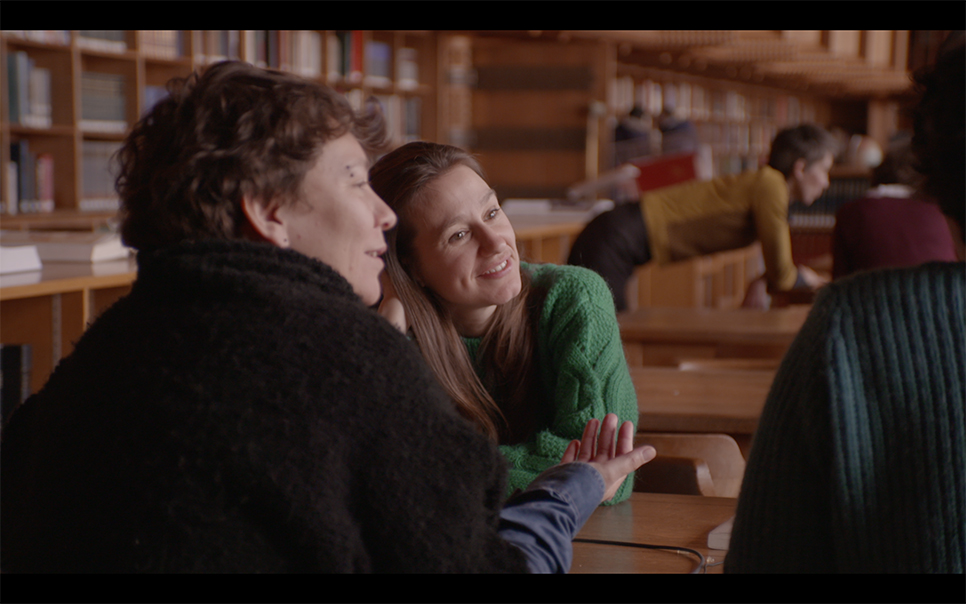
Dora García, La Eterna, 2017. Courtesy of Auguste Orts and the artist
Dora García lives and works in Barcelona and Oslo. She teaches currently at Oslo National Academy of the Arts and HEAD Genève, and is co-director of Les Laboratoires d’Aubervilliers, Paris. She has represented Spain at the Venice Biennale in 2011 and was present again in the Venice Biennale 2013 (collateral events). She took part in the 56th Venice International Art Exhibition, dOCUMENTA(13) and other international events such as Münster Sculpture Projects in 2007, Sydney Biennale 2008 and São Paulo Biennale 2010. Her work is largely performative and deals with issues related to community and individuality in contemporary society, exploring the political potential of marginal positions, paying homage to eccentric characters and antiheroes. These eccentric characters have often been the center of her film projects, such as The Deviant Majority (2010) and The Joycean Society (2013).

Veronika Hauer, It’s not visual – it’s kinetic, 2019, shown as part of My Summer is your Winter, Grazer Kunstverein, 2019. Photography by Christine Winkler
Veronika Hauer’s double-sided portraits of apes swing from the ceiling like animals in a cage. They are joyful and tragic, a troupe of animals assembled for presentation, like a group of trapeze artists suspended on a stage. Hauer found inspiration in J. M. Coetzee’s Elizabeth Costello, particularly in an excerpt where Elizabeth notes that only a poet can truly empathise with animal kin, going beyond the purely analytical to explore what on earth a chimp might be thinking when faced with humankind and their strange accessories.
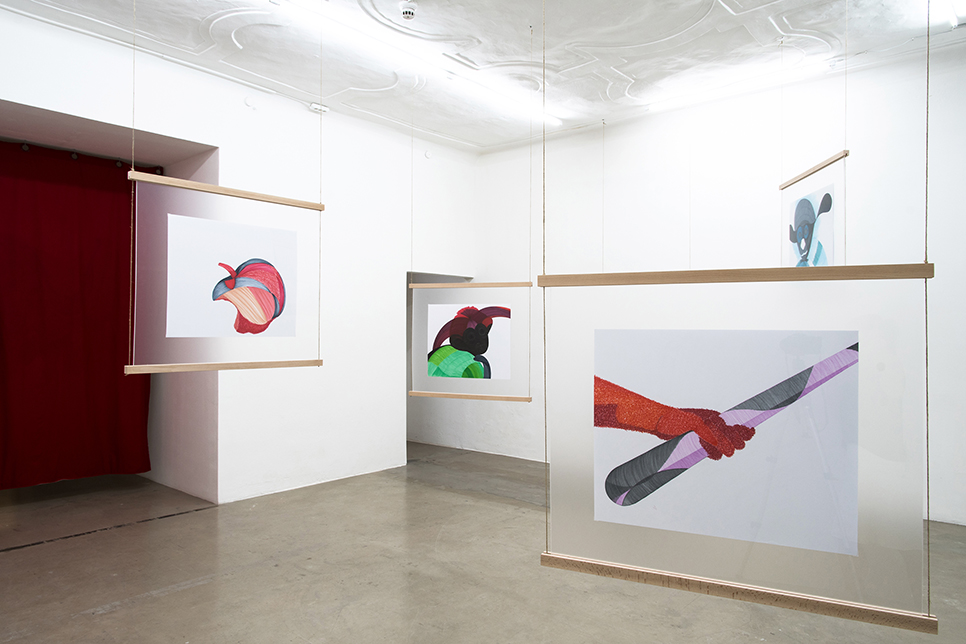
Veronika Hauer, It’s not visual – it’s kinetic, 2019, shown as part of My Summer is your Winter, Grazer Kunstverein, 2019. Photography by Christine Winkler
Costello is reflecting on Wolfgang Köhler and his analytic attempts to interpret the actions of a set of captive chimpanzees who, in his opinion, took on military band characteristics when they clung to scraps of fabric and marched in a circle, completely voluntarily, in their compound. Elizabeth notes however that: Nothing in their previous lives has accustomed the apes to looking at themselves from the outside, as if through the eyes of a being who does not exist. So, as Köhler perceives, the ribbons and the junk are there not for the visual effect, because they look smart, but for the kinetic effect, because they make you feel different — anything to relieve the boredom. This is as far as Köhler, for all his sympathy and insight, is able to go; this is where a poet might have commenced, with a feel for the ape’s experience.*

Veronika Hauer, It’s not visual – it’s kinetic, 2019, shown as part of My Summer is your Winter, Grazer Kunstverein, 2019. Photography by Christine Winkler
Köhler was probably a good man, Elizabeth notes, but he was not a poet. Hauer interprets and represents the apes in a different way, ushering them into being through the repetitive kinetic action of producing patterns (drawings composed of lines, stars, circles). These patterns form images, holding within them a sense of the time and repetition it took to produce them. Each portrait is twinned with something alluding to material touch – an outstretched hand clinging to a fabric swathe, or some textile fragment slipping through fingers. The works are filled with the potential for movement, but hang motionless in the space between that which can be known, and that which can be imagined.
*J. M. Coetzee, Elizabeth Costello, Penguin 2003, p. 74

Veronika Hauer, It’s not visual – it’s kinetic, 2019, shown as part of My Summer is your Winter, Grazer Kunstverein, 2019. Photography by Christine Winkler
Veronika Hauer lives and works in Graz. She studied at Goldsmiths College London, the University of Applied Arts Vienna and École supérieure d’ Arts graphiques, Paris. Hauer is co-founder and editor of the online magazine on contemporary art Nowiswere. She is working as a lecturer for Performative Practises at the University of Applied Arts Vienna (Department of Art and Communication Practice). Her work has been presented at the ICA London, Galerie im Taxispalais, Innsbruck, Glasgow International Festival, and widely in Vienna and Graz, most recently at Forum Stadtpark and Kunsthaus Graz.
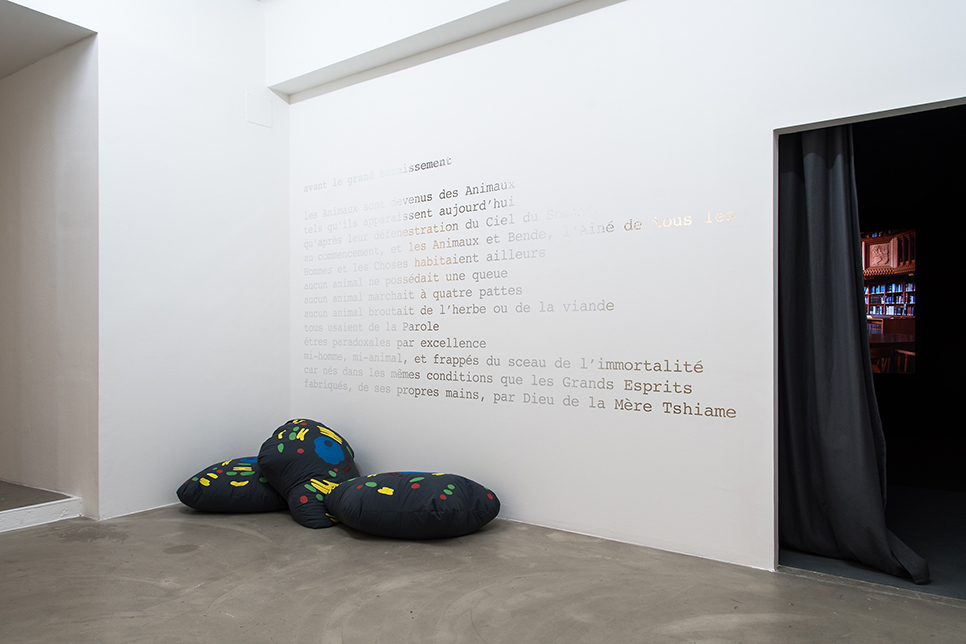
Fiston Mwanza Mujila, Avant le grand bannissement, 2019, shown as part of My Summer is your Winter, Grazer Kunstverein, 2019. Photography by Christine Winkler
Fiston Mwanza Mujila
avant le grand bannissement, 2019
Newly commissioned poem, printed on wall in vinyl text
Translated from the original (French) to English by Roland Glasser.
Before the great banishment
the Animals became Animals
as they appear today
after their defenestration from Highest Heaven
in the beginning, and the Animals and Bende, the Elder of all Men and Things dwelled elsewhere
no animal possessed a tail
no animal walked on all fours
no animal grazed on grass or meat
all employed the Spoken Word
paradoxical beings par excellence
half-man, half-animal, and stamped with the seal of immortality
for born into the same conditions as the Great Elders
and created, with his own hands, by the God of
Mother Tshiame
avant le grand bannissement
les Animaux sont devenus des Animaux
tels qu’ils apparaissent aujourd’hui
qu’après leur défenestration du Ciel du Sommet
au commencement, et les Animaux et Bende, l’Aîné de tous les Hommes et les Choses habitaient ailleurs
aucun animal ne possédait une queue
aucun animal marchait à quatre pattes
aucun animal broutait de l’herbe ou de la viande
tous usaient de la Parole
êtres paradoxales par excellence
mi-homme, mi-animal, et frappés du sceau de l’immortalité
car nés dans les mêmes conditions que les Grands Esprits
fabriqués, de ses propres mains, par Dieu de la Mère Tshiame
Fiston Mwanza Mujila, born in 1981 in Lubumbashi and living in Graz, is a French language Congolese writer. In 2009 he received an award for a literature contribution on the occasion of the Francophone Games in Lebanon. His debut novel Tram 83 was on the longlist of the Man Booker International Prize in 2015 and received the Etisalat Prize for Literature as well as the International Literature Prize of the House of Cultures of the World in 2017. In 2018 it was adapted for the stage and premiered at Schauspielhaus Graz as part of steirischer herbst festival 2018. Poetry collections such as Le Fleuve dans le Ventre / Der Fluß im Bauch have also been presented in a performance-oriented setting, such as at Grazer Kunstverein as part of the Summer Season programme in 2017. Since 2009 Mwanza Mujila has lived in Graz and teaches African literature at the Karl-Franzens- University of Graz.

Fahim Amir, Vegans on Coke: Politics Over Morals
Verkokste Veganer*innen: Politik statt Moral
Text extracts originally published in Fahim Amir, Schwein und Zeit, Tiere, Politik, Revolte, Edition Nautilus, 2018, shown as part of My Summer is your Winter, Grazer Kunstverein, 2019. Photography by Christine Winkler
Fahim Amir
Vegans On Coke: Politics Over Morals
Verkokste Veganer*innen: Politik statt Moral
Text extracts originally published in Fahim Amir, Schwein und Zeit, Tiere, Politik, Revolte, Edition Nautilus, 2018
Translated from the original (German) to English by Kate Howlett Jones.
Amir writes with ferocity and conviction. Like Elizabeth Costello, to whom this exhibition is dedicated, no one escapes Amir’s sharp tongue and sober criticism of the contemporary moment: From vegans, to cokeheads, to the bourgeoisie. His texts almost violently interrupt the polite flow of the exhibition, in much the same way as Elizabeth’s words refused to be brushed aside. For a full takeaway pamphlet of Vegans On Coke: Politics Over Morals, complete with footnotes, please ask at the reception desk.

Fahim Amir, Vegans on Coke: Politics Over Morals
Verkokste Veganer*innen: Politik statt Moral
Text extracts originally published in Fahim Amir, Schwein und Zeit, Tiere, Politik, Revolte, Edition Nautilus, 2018, shown as part of My Summer is your Winter, Grazer Kunstverein, 2019. Photography by Christine Winkler
Fahim Amir is a philosopher and cultural scientist, working at the intersections of nature, cultures and colonial historicities, transcultural agency and urbanism. Amir was curator of Live Art Festival 2013 Zoo3ooo: Occupy Species (Kampnagel, Hamburg) and Salon Klimbim: Feeding Vegetarian Tigers – Entertaining Utopian Sensibilities (Secession Vienna, 2014). Amir co-edited Transcultural Modernisms (Sternberg Press, 2013) and recently provided the afterword to the German translation of Donna Haraway’s Companion Species Manifesto (Merve, 2016). His most recent publication Schwein und Zeit. Tiere, Politik, Revolte, was first published in 2018. It was praised with hymnic reviews both in academic journals and the press, and won the Karl Marx Prize 2018.
Morten Norbye Halvorsen’s project received support from OCA Norway (Office for Contemporary Art Norway). Special thanks to legero united – the shoemakers | Initiator of con-tempus.eu for supporting the commissioning of new works by Belgian based artists Laurie Charles and Chris Evans.
|
![]()
![]()